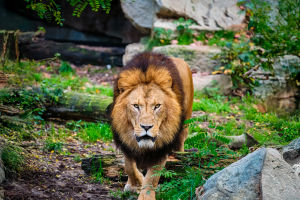Walk through any dense forest, and you might think it's quiet and empty.
But look closely, and you'll notice a sudden flicker of movement—a bird, a lizard, or even a small mammal blending perfectly with the leaves and shadows. Camouflage is nature's secret tool, helping animals survive in environments filled with predators. Without it, life in the forest would be far riskier and far shorter.
Color and Pattern
The first layer of camouflage is color. Many forest animals have coats, scales, or feathers that match their surroundings. A fawn's spotted coat mirrors the sunlight filtering through leaves, making it nearly invisible to predators. Likewise, insects often have intricate patterns on their bodies that mimic leaves, bark, or moss. This isn't random—it's the result of thousands of years of evolution, where individuals who blend in are more likely to survive and pass on their traits. Even bright-colored frogs often position themselves on similarly colored leaves to avoid standing out.
Shape and Movement
It's not only color that helps animals disappear. Shape and movement are equally crucial. A stick insect doesn't just look like a twig; it sways gently as if moved by the wind, tricking even sharp-eyed birds. Some frogs have irregular body outlines that break up their shape against the forest floor. Even larger mammals, like jaguars, have spots that create a disruptive pattern, making it harder for prey to recognize a solid shape moving through dappled sunlight. Movement, slow or subtle, prevents detection while staying alert.
Behavioral Camouflage
Camouflage isn't only physical; it's behavioral. Many animals choose where to rest or feed based on how well they can hide. Birds may perch under dense foliage, while small rodents stay close to tree roots or thick underbrush. Some predators use the same trick, blending with the environment to ambush unsuspecting prey. Timing also matters—creatures may be more active at dawn or dusk when light conditions make them less visible. Even sounds are controlled; some animals move quietly or freeze completely when danger is near.
Seasonal Adaptation
In some forests, camouflage changes with the seasons. Snow-covered forests see animals like hares and weasels develop white coats, while in warmer months, their brown or gray fur matches fallen leaves and soil. Birds may molt into duller plumage to avoid drawing attention during nesting. These seasonal shifts highlight the incredible flexibility and survival instincts of forest species. Adaptability in appearance ensures they remain hidden, whether stalking prey or evading predators.
Group Camouflage
Some forest animals also benefit from being in groups. Flocking birds or schooling fish create patterns of movement that confuse predators. Herd animals may align themselves with shadows or tall grasses, reducing the chance any individual gets singled out. Even insects like leafhoppers or caterpillars gather on leaves in ways that make them appear as a single object rather than multiple targets. Group camouflage shows that survival often depends not just on the individual, but on social strategies.
Takeaway
The forest is a world of hidden battles. Every leaf, shadow, and pattern matters in the struggle to survive. Camouflage is more than a visual trick—it's an essential survival strategy shaped by evolution, behavior, and environment. Next time you walk in the woods, take a moment to observe. You might be amazed at the number of creatures hiding in plain sight, each mastering its own version of disguise to stay safe, find food, and thrive. Observing these strategies reminds us how finely tuned nature is, and how every detail, from color to movement, plays a crucial role in survival. By noticing these tiny secrets, we can learn to appreciate the subtle genius behind every forest creature.


